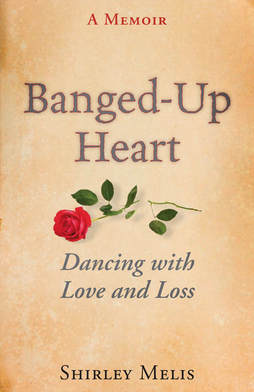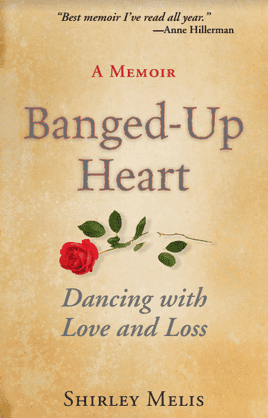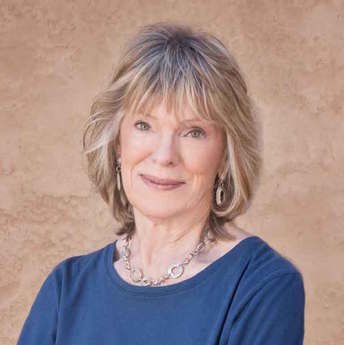 “It’s too grim.” College classmate and author Leslie Garis stared at the poster displaying the cover of my not-yet-completed memoir, Banged-Up Heart. “What do you think?” she asked Marjorie, standing nearby. “I agree. Can you re-take the photo?” I swallowed hard and shook my head no. To gauge classmates’ interest in my memoir, I’d asked a graphic artist to create a poster display for my college reunion. I gave her a photo of a burned out forest -- skeletal black trees, some standing and others strewn like matchsticks across a carpet of green grasses – to use as a book cover. To me the grasses symbolized re-growth. Perfect for my memoir, which is about courage and resilience in the face of heartbreak. And especially meaningful because my story focuses on my life with John who took the photo. But in the poster, the grasses looked more beige than green, almost invisible. My classmates were right: too grim. Even if the grasses were greener, the overwhelming feeling was one of desolation. Reluctantly, I gave up the idea of John’s forest photo as a cover. Months later, after landing a publisher, I found myself facing the cover question with a deadline looming. “Take a look at memoirs in bookstores and see what kinds of covers grab you,” my publicist suggested. In the bookstore I found several with forest covers but these books were about actual treks through forests. The covers that grabbed me were brighter in color but I was no closer to knowing what I wanted. Audibly fretting, I heeded the advice of artist friend Lewis Hawkins: “Get a pencil and paper and start doodling. You’ll come up with something.” At breakfast one morning, I showed my doodle -- banged-up looking letters for the title separated from the subtitle by a rose – to my husband Frank. “Here,” he said, pencil in hand. “Break the stem of the rose.” Eureka! By breaking the rose stem, he captured the essence of my subtitle, Dancing with Love and Loss. I shared our doodle with friends at dinner who applauded. Why the rose? I can’t tell you. It must have been subconscious. In fact, roses frequently appear in my memoir. But it was graphic artist Scott Gerber, publisher of Terra Nova Books, who turned my doodle into a winner. The cover of Banged-Up Heart: Dancing with Love and Loss won first place in the 2017 Southwest Book Design and Production Awards competition.
2 Comments
When owner Dorothy Massey offered me a Reading/Signing at Collected Works, I was euphoric. Reading at Collected Works, Santa Fe’s #1 independent bookstore, would be a dream come true. But what parts of my 300-page memoir would I read?
“You need a program,” said editor Morgan Farley, who suggested I take a look at some author videos on YouTube. I clicked on a YouTube of one author who impressed me because she looked and sounded spontaneous. Much to my surprise, I found when clicking onto her other YouTube videos that she’d repeated the same “program” time after time. Heartened by the idea that I might put together a reading I could use more than once, I selected passages that followed my story line without revealing the ending. For a practice reading in front of Morgan, I copied pages from a pdf of my book. Squinting to read without my glasses and rushing through the passages, I could see the disappointment in Morgan’s face. “You have time,” she said, “to make this good. I’ve heard you read before; I know you can do it. You can find a recording machine at Best Buy for $100. Get one and listen to yourself.” Over the next few days, I made a few decisions:
For the next few mornings, I practiced my patter aloud during 30-minute treadmill sessions. I wanted to memorize it so that I could look up and out at the audience except when looking down to read the passages. In the afternoons, when nobody was around, I’d tape myself. Eventually, I was satisfied with my reading, my voice inflections and pauses. (Morgan, a poet who reads beautifully, was a great help with this.) And then there was the question of using a microphone. At Collected Works, I would be on a small stage, a platform three giant steps above the main floor. One afternoon, about a week before my reading, Dorothy arranged for one of her staff to set up the microphone so I could test the sound and determine how close I needed to be to the mouthpiece. She offered a music stand onto which I’d drop my pages as I read. The day of my reading, I awoke feeling a little nervous but as ready as I could be. That evening, before an audience of 115, I learned that my initial concerns, subsequent decisions and practice paid off.  A few months after my husband’s death, I told close friends I was going to write about my life with him, cut short two years after we married. I felt blindsided, but by what I didn’t know. By John? By my own naivete? I had to figure it out. A writer most of my life, I was comfortable putting pen to paper. Aided by a journal I’d kept and a boatload of emails I’d written during John’s last months, I set out to tell my bittersweet story. After two years of grieving for my first husband, I’d been swept up into a whirlwind romance by a younger man who was a rocket scientist. We married and created an adventurous new life together. We were supremely happy – and then I lost him to a brain tumor. Day and night, in Santa Fe and Reston, Va., I sat at the computer, my fingers flying across the keyboard, capturing the essence of my two-year odyssey. Friends read my drafts and came back with questions that caused me to re-think and re-write. Over tea at Collected Works Bookstore in Santa Fe, I handed my manuscript to editor Morgan Farley. “I’ve been writing for three years, and this is what I’ve produced,” I said. “I know there’s something missing but I don’t know what it is.” “I know what’s missing,” Morgan said in a phone call a couple of weeks later. Relief washing through my body, I grabbed a pen to schedule another meeting. “You have three books in one,” she began. “I’ve made a note of the pages devoted to each and would suggest you go with the one that has the most pages because that seems to be where your strongest energy is.” I’d started off on the energized track, but a close friend who’d known and loved my first husband Joe suggested I also write about my life with him. Once I’d done that I thought, Why not write about my life before Joe – about Nikos in Greece and while I’m at it, my troubled mother? Back on track, I listened to Morgan talk about the craft of novel writing and how it applies to writing memoir. She explained that a story comes alive when you create scenes to show action, and use dialogue to reveal personality and character. We talked about using description but not too much, to allow the reader to use her imagination, and pacing by relieving highly charged scenes with narrative while keeping the story moving. It was a lot for me to absorb. A history major in college, I hadn’t read many novels; I’d read original sources and become practiced at critiquing authors’ premises and their use of sources to back them. Later, in my professional life, I did a lot of business writing – press releases where scene-setting meant naming the place where a meeting was held and dialogue meant adding direct quotations by speakers that revealed neither personality nor character. Rewriting my memoir to give it the missing ingredients sounded challenging. “If you choose to do this, it will be transformative,” Morgan said. Over the ensuing months, Morgan frequently asked, “What were you feeling?” – inviting me to dig deep for my interior emotional state. She helped me to confront my story as I lived it, subjectively, and to reflect, time and again, on the significance of my feelings, thoughts and actions. Looking deep inside to find my truths, when I wasn’t by inclination introspective, challenged me. Having the courage to put them on paper, even those I might not like, meant overcoming my own inhibitions and ignoring the advice of well-meaning friends who believed personal publicity of any sort should be limited to births, marriages and deaths. “It’s too personal,” a good friend confided after reading the first several pages. The greatest joy in writing Banged-Up Heart was hearing Morgan say, “Beautiful, beautifully expressed.” Or, “I just kept reading, forgetting I was supposed to be editing.” I also heard from Morgan, “Shirley, I’m sorry but this doesn’t work.” And I’d toss eight hours worth of carefully crafted prose. The successive joys of landing a top-notch agent, Liz Trupin-Pulli, and a publisher, Terra Nova Books, are more than icing on the cake. They’ve made it possible for me to bring my years of hard work to fruition.  Banged-Up Heart by Shirley Melis Banged-Up Heart by Shirley Melis “You should start a blog, Shirley,” my friend Art said. “Why?” I asked. “Haven’t I said everything I wanted to say in my memoir?” “Yes, by writing Banged-Up Heart, you shared an intimate and clear-eyed account of finding love late and losing it early – and the strength it takes to love again. Now that you’ve done that, some people will want to know how you did it -- how were you able to write a book like this and how did you become an author?” “That’s a whole other story,” I said. “Yes, and it’s one you should tell.” “But who would care?” I asked. “Aspiring authors,” Art answered. He convinced me – sort of, halfway, a little. But on the off-chance that he’s right, that my experience writing Banged-Up Heart and then pulling off that other huge job of taking it to publication might help an aspirant or two, I’ve decided to plunge in. I wrote my story not to sell it but purely because of compulsion. I had been widowed twice in four years. The second time, I was totally blindsided, needing desperately to figure out what had happened. So I followed a path that had led to answers before. All through my career, writing had helped me see more clearly. Hoping to do that again, I began what became Banged-Up Heart. At first, I just wanted to relive the wonderful relationship John and I had had. But once I got started, I became wiser, I think – more curious, more demanding. I was determined to face the questions I had never asked him. In the end, celebrating the relationship was not nearly so important as getting as close to the truth as I could. Only when a close friend said after an early draft, “Others will want to read your story” did I first think about publication. The trek those words led me to was a long way from straight, filled instead with unexpected twists and turns. Hoping for more than pointers, I attended a writers’ workshop in New York City. The allure was not tips on the craft of writing (which I thought I knew) but the possibility of a publishing house editor asking for a chapter or two, maybe more, of my still-in-progress memoir. Emboldened by this chance to be taken seriously by industry professionals, I prepared my pitch. Editors from Random House, Penguin, Harper Collins, and other major publishers listened. While other aspiring authors at the workshop seemed mesmerized, not one editor asked to see more. Undaunted, I kept writing. A couple of years later, I engaged an editor whose knowledge steered me to essential recasting and rewriting, which brings me to my first posting, On Working with an Editor. Future postings will cover choosing a title, finding an agent and a publisher. I’ll be talking about things like this as part of my Trek to Publication, and also will be blogging about Travel as well as Life in the High Desert of New Mexico. |
Author BLOG
I'm Shirley Melis. You may know me as Shirley M. Nagelschmidt, Shirley M. Bessey and now, Shirley M. Hirsch. Each reflects a particular phase of my life. Banged-Up Heart is a slice of my life's journey and in telling my story, I'm giving voice to my long silent "M" by reclaiming my maiden name, Shirley Melis. Archives
January 2024
Categories
All
|

 RSS Feed
RSS Feed